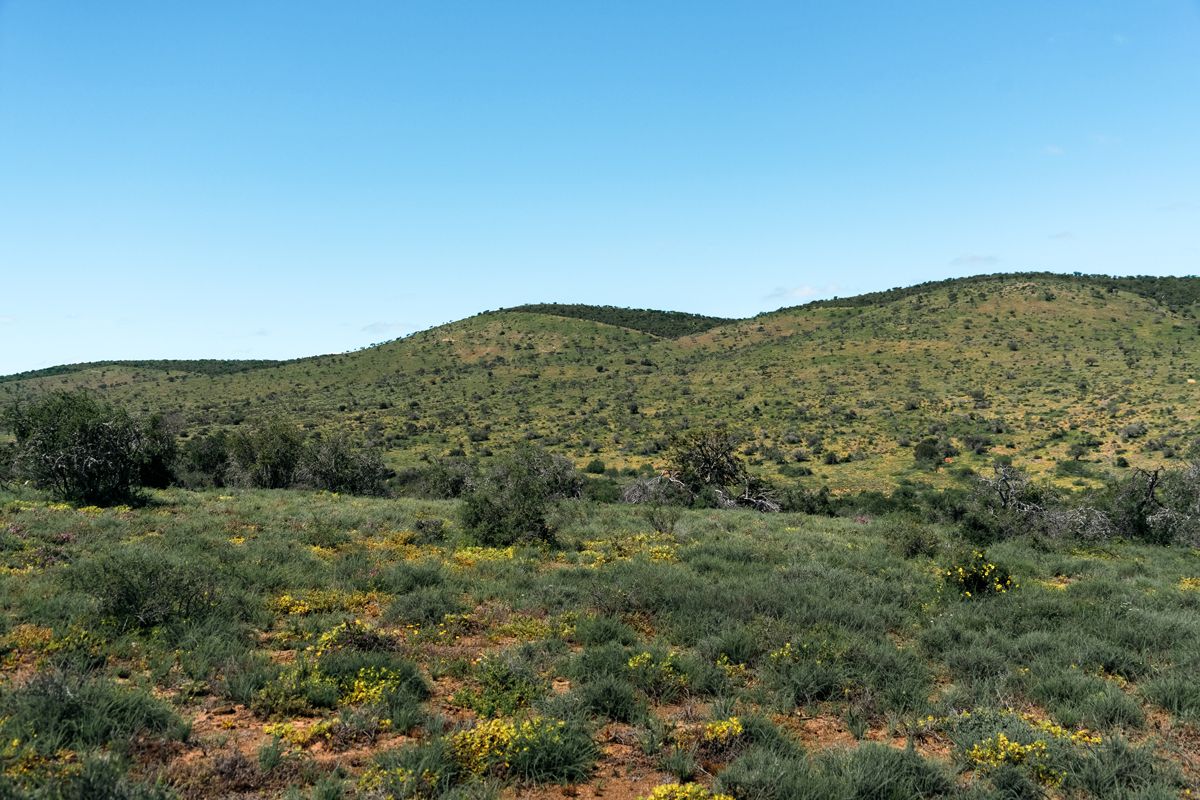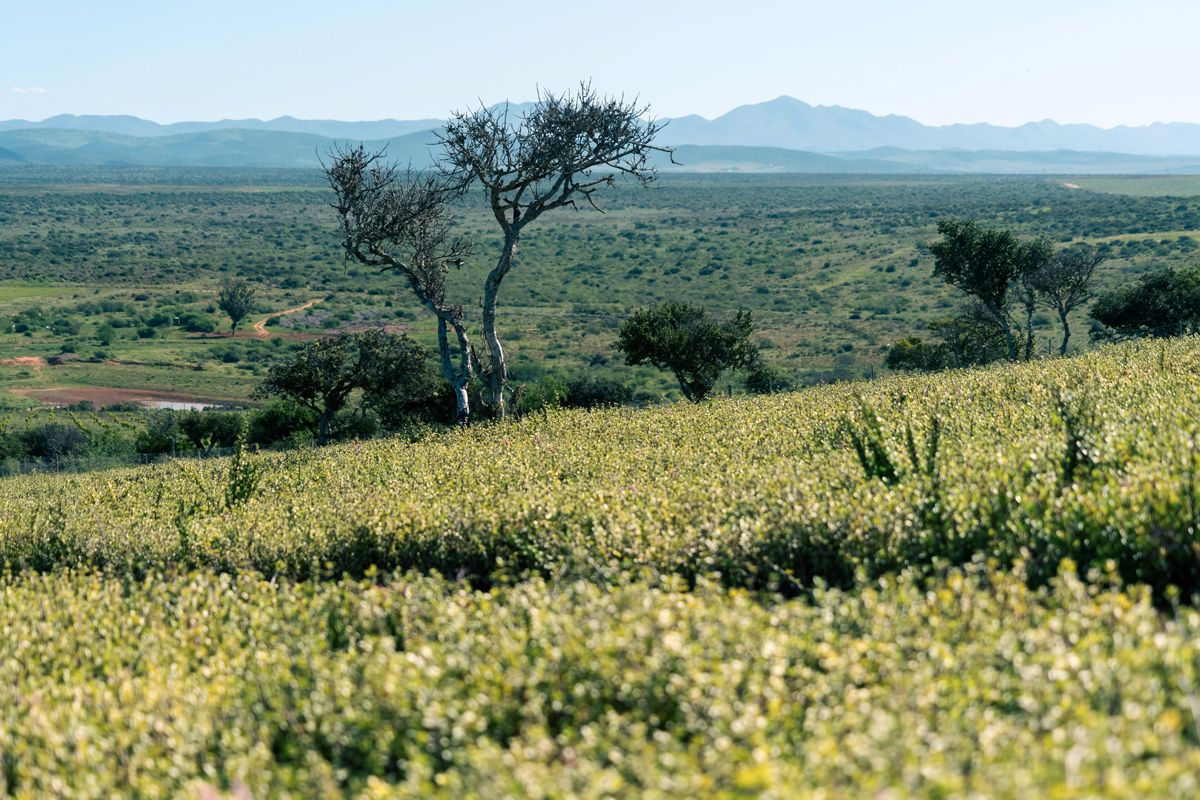South Africa's Albany thickets are unique ecosystems, representing one of the country’s greatest reservoirs of floral diversity and functioning in synergy with the rich fauna that they shelter. The arid subtypes of thicket are often characterized by the dominance of an endemic tree species, Portulacaria afra, locally known as spekboom and endowed with extraordinary physiological characteristics, but these ecosystems have been severely degraded by intensive livestock farming over the past century. While the consequences of this degradation are particularly severe for the environment and local communities, scientists are working to implement the world's largest ecosystem restoration experiment. Since 2020, Reforest'Action has been contributing to this effort, which aims to restore 1.2 million hectares of subtropical thickets in the Eastern Cape province of South Africa.
The Albany thicket, a biome like no other in the world
A biome in its own, within a country rich in contrasts
South Africa is a land of contrasting landscapes, with a wide variety of biomes - deserts and grasslands, savannahs and forests - juxtaposed across its diverse surface. It was only in 1996 that Albany thickets were classified within a distinct biome. Consisting of a single, dense stratum of low shrubs and trees, festooned with climbers and succulents, they are mainly located in the Eastern-Cape province of South Africa, in the catchments of the Fish, Sundays and Gamtoos rivers, and along the coastline from Port Elizabeth to East London.
With their origins in the Eocene (56-33.9 million years ago), they are descended from ancient rainforests that adapted to a semi-desert environment as the area was subjected to continental drift and aridification. They are thus home to numerous lineages of prehistoric plants and tropical species whose ranges today extend as far as West Africa, making them one of the country’s largest reservoir of plant diversity. Evergreen and deciduous trees, succulents, creepers, shrubs, vines, bulbs and grasses... More than 1,560 plant species, 20% of which are endemic, have been recorded in the Albany thicket, which also constitute the natural habitat of a rich avian, entomological and reptilian fauna, as well as large indigenous mammals such as the elephant, black rhinoceros, leopard and kudu.

Spekboom, the ecosystem engineer of Albany arid thickets
One feature makes exceptional the arid subtypes of Albany thickets: they are the only thicket ecosystems in the world to be dominated - up to 80% of their vegetation - by a succulent species, Portulacaria afra. This tree, endemic to southern Africa, whose Afrikaans name, spekboom, means "fat tree" because of its fleshy, succulent appearance, can grow up to 6 meters high and live for up to 200 years. Its pioneering character, resilience, and ability to ensure the stability of ecosystems and their biodiversity make it a particularly remarkable species, which is why Albany arid thickets are commonly referred to as Spekboom thickets.

With an uncommon physiological adaptation, spekboom adapts to its rapidly changing environment reflexively by shifting its photosynthetic pathway when water availability decreases, meaning that it can take advantage of wet periods, growing rapidly in C3 mode, and then survive droughts by adopting the CAM metabolic pathway. Because its stems and leaves are 70-90% water, as well as its hardy physiology, spekboom also improves soil infiltration and water content thanks to its root system, creating a local microclimate that is essential for the germination and establishment of many other plant species in the ecosystem, and for maintaining a high plant biomass. The extreme biomass generated by spekboom is also an advantage for soil carbon storage. By maintaining the soil cooler, away from direct sunlight, spekboom allows the litter (the surface layer of soil made up of plant debris) to decompose more slowly and prevents the release of CO2 into the atmosphere. As a result, organic carbon is retained longer in the upper layers of the soil. This richness in carbon is beneficial to the ecosystem as a whole, since the richer the soil is in carbon, the better its water retention capacity. So, when the occasional heavy rainfall occurs, the soil beneath the spekboom canopy acts like a sponge, preventing runoff and retaining both water and nutrients, which are then slowly released during periods of drought to support all the flora in the thickets.

Thanks to their high biomass, thickets dominated by spekboom are also capable of sustaining exceptional densities of megaherbivores, such as elephants and black rhinocerose. Spekboom is thus a dominant and crucially important species in the arid subtypes of the Albany thicket ecosystem, supporting a whole host of plant and animal species that depend on it to thrive. On the contrary, its removal from the landscape leads to the collapse of the entire ecosystem.

The livestock industry at the root of the decline in Albany thickets
80% of Albany thickets degraded by overbrowsing
At the end of the 19th century, Albany thickets covered 1.5 million hectares of a dense, impenetrable vegetation in South Africa’s Western and Eastern-Cape provinces. Today, only about 300,000 hectares of intact thickets remain, most of them in protected nature reserves. This means that 1.2 million hectares, or 80% of the ecoregion’s total surface area, have disappeared or been seriously degraded in just over a century. The cause is, to a very large extent, the industrialization of mohair, a woolly fiber derived from the fur of the Angora goat. South Africa now produces 54% of the mohair sold in the world, making it the world’s leading producer, far ahead of Lesotho (12%) and the United States (11%). Because of the rapid growth of its wool, the Angora goat has high food requirements, which results in the desertification of the thicket on which it grazes. The increase in global demand for mohair has also led farmers to practice intensive livestock farming where the number of herbivores on the plots far exceeds the carrying capacity of the ecosystem, i.e., the maximum number of animals that a given area can tolerate without significant damage to the vegetation and soil.

Heavy environmental and social consequences
Today, the ongoing degradation of the Albany thicket continues to lead to the breakdown of ecological function, and the loss of ecosystem services these systems once provided. With the loss of plant cover, the soils are becoming thinner, hotter and drier, and they are losing the network biological processes and the carbon stored in their upper layers. At a local scale, the disappearance of the microclimate created by the spekboom is exacerbating increasingly frequent droughts in the context of climate change. Without its contribution to the infiltration of water into soils and aquifers, springs and rivers will dry up. All these environmental consequences are leading to the erosion of the ecosystem’s extraordinary animal and plant biodiversity. As a result, the entire ecosystem collapses and is transformed from a lush forest into an eroding and desert-like landscape. Across the Eastern-Cape, the visual contrast is striking as one can find clear boundaries between thickets and desert, separated by fences.

From a socio-economic point of view, much of the land is now too degraded for farmers to be able to raise livestock profitably and sustainably. The availability of other natural resources from the thickets, such as firewood, edible and medicinal plants, is diminishing for rural communities, which has a direct impact on their incomes and livelihoods.

Restoring the Albany thicket: science at the heart of the process
The ambition to restore 1.2 million hectares
Faced with these serious environmental and social consequences, action has been underway for two decades to restore the Albany thicket and rebuild their precious natural capital. Since 2020, Reforest’Action has been contributing directly to these restoration actions thanks to the vision of Dr. Anthony Mills, a scientist specializing in ecology and soil science, who has been conducting research on Albany thickets for the past twenty years. Anthony Mills is also the founder of C4 EcoSolutions and AfriCarbon, a South African company whose mission is to restore all the degraded thickets in the Eastern and Western-Cape provinces - a total of 1.2 million hectares. "How do you get to such a scale, in terms of restoration, in the most systematic, efficient and fast way possible?" asks Anthony Mills. "In my opinion, science must be the foundation and the driving force of the process, the fuel needed to bring ecosystem restoration to the scale of hundreds of thousands of hectares. Firstly, to document all the benefits that will be generated by the restoration of the Albany thicket and to encourage investors to support such projects - conservation of biodiversity, return of carbon to ecosystems, improvement in the carrying capacity of landscapes and therefore the productivity of land, increase in the quantity of water flowing into aquifers, etc. Secondly, to understand the best way of implementing this restoration."

A laboratory to advance the science of restoration
Supported by the public and private sector and enhanced by restoration experimentations by farmers on their own plots, the work of Anthony Mills and the community of scientists who have worked on subtropical thickets over the last twenty years has produced a practical and effective restoration mechanism to re-establish thickets where they have disappeared or been severely degraded. At the heart of this mechanism is the spekboom, the only species capable of initiating the regeneration of the great plant diversity in this area of the Albany thicket biome. Because the soil in degraded thicket areas can reach extreme temperatures - up to 70°C - spekboom is the only species capable of withstanding such heat without irrigation. Once planted, it is capable of lowering soil temperatures to as low as 30°C. In these cooler, moister soils, the plant species typical of subtropical thickets - plants, trees, shrubs, succulents, lianas, etc. - can once again establish themselves thanks to zoochory (dispersal of seeds by animals, particularly birds). Moreover, spekboom’s remarkable ability to rapidly fix CO2 both in the soil and in its above-ground biomass, makes this tree an asset for mitigating climate change on a global scale. But the task is enormous: to restore 1.2 million hectares of degraded thicket, AfriCarbon estimates that 5 billion trees will be needed.

Drawing on twenty years of research and experimentation carried out as part of a continuous improvement approach, Anthony Mills and the entire AfriCarbon scientific team have been able to establish and adjust restoration protocols that today optimize the rapid return of spekboom to the ecosystem, and thus of all its plant community. This open-air laboratory will continue the world’s largest ecosystem restoration experiment for years to come.
The total disappearance of Albany thickets and their valuable ecosystem services is not inevitable. As well as conserving the intact remnants of the thicket, restoring areas that have been severely degraded is now a priority. Twenty years of scientific research have shown that spekboom has a central role to play in this restoration through its ability to influence soil health and the water cycle, and to create the microclimate necessary for the resurgence of rich plant and animal biodiversity. By making a long-term commitment to AfriCarbon, in particular through the funding of the Kuzuko carbon project, which is VCS-certified by Verra, Reforest’Action is joining forces with the ambition to sustainably restore these ecosystems, which are unique in the world, and the vast array of their environmental and socio-economic benefits.
ACKNOWLEDGMENTS
- The Kuzuko project was notably funded by Capgemini, a global leader in partnering with companies to transform and manage their business by harnessing the power of technology. Capgemini is committed to a 90% decarbonization by 2040 and in addition is investing in high integrity carbon credits to abate and remove carbon from beyond their own value chain.
- The scientific information and figures concerning the physiological characteristics of spekboom come from interviews conducted by Reforest'Action with Anthony Mills, Doctor of Soil Science and Founder of AfriCarbon, and Robbert Duker, Doctor of Plant Environmental Physiology and Chief Operations Officer of AfriCarbon, or from their published, peer-reviewed scientific work.
- All the photographs illustrating this article were taken by Reforest'Action.